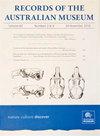The flint artefacts from two workshops at Wadi el-Sheikh, Eastern Desert, Egypt
IF 0.8
4区 生物学
Q4 ZOOLOGY
引用次数: 0
Abstract
A stone quarry at Wadi el-Sheikh is recognized as an important source of flint in ancient Egypt. In 1896–1897 a substantial sample of stone artefacts, from fifteen separate workshops, was collected and placed in various museums across the world. This material remains virtually unknown, including two assemblages kept in Australia, which are analyzed in this study. It is evidenced that both workshops produced predominantly flint knives and a smaller number of cleavers for distribution away from the quarry, in an earlier part of the third millennium Before the Common Era (BCE) often referred to as the Early Dynastic Period (c. 3150–2686 BCE) and Old Kingdom (c. 2686–2181 BCE). There is a strong indication that the workshops represent a tiny portion of a large supply network. Two types of tools, a pick and a hoe, are recognized as digging implements associated with a quarry, but are also present on sites in Egypt where excavation took place.来自埃及东部沙漠Wadi el Sheikh两个作坊的燧石工艺品
Wadi el Sheikh的一个采石场被认为是古埃及燧石的重要来源。1896年至1897年,来自15个独立工作室的大量石器制品样本被收集并存放在世界各地的各个博物馆。这种材料实际上仍然未知,包括本研究中分析的保存在澳大利亚的两个组合。有证据表明,这两个作坊主要生产燧石刀和少量切肉刀,用于在采石场以外的地方分发,时间是公元前三个千年的早期,通常被称为早期王朝时期(约3150–2686年)和旧王国时期(约2686–2181年)。有强有力的迹象表明,这些车间只占大型供应网络的一小部分。有两种类型的工具,一种是镐和一种是锄,被认为是与采石场有关的挖掘工具,但在埃及的挖掘现场也有。
本文章由计算机程序翻译,如有差异,请以英文原文为准。
求助全文
约1分钟内获得全文
求助全文
来源期刊
CiteScore
0.90
自引率
0.00%
发文量
9
审稿时长
>12 weeks
期刊介绍:
Records of the Australian Museum, volume 62 was published in 2010, volume 63 in 2011. Monographic works of particular significance are published irregularly as Records of the Australian Museum, Supplements (ISSN 0812-7387).

 求助内容:
求助内容: 应助结果提醒方式:
应助结果提醒方式:


